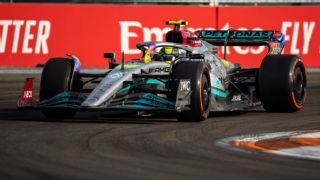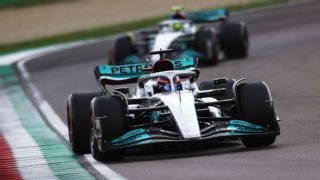|
The storyline surrounding Mercedes ahead of each race this season has been the same: will this be the weekend the reigning F1 world champions finally unlock the potential of their car? Yet with almost a quarter of the season complete, increasingly the question is whether the potential is there at all and whether Mercedes is heading down a developmental cul-de-sac with its unique car concept. Lewis Hamilton and Mercedes both wrote off the prospect of challenging for the 2022 title two races ago at the Emilia Romagna Grand Prix, when it appeared as though the team had reached a new low. Hamilton qualified 13th at Imola, dropped to 14th on the grid after the sprint race and finished the grand prix where he originally qualified in 13th. Teammate George Russell has been more consistent, grinding out top-five finishes at the first five races, but Mercedes' lack of performance has meant that neither driver has stood a chance of challenging Red Bull and Ferrari for race wins. The hope is that Mercedes can develop its car back up the grid by bringing upgraded parts to upcoming races, but the solution might not be that simple. Why is the Mercedes so slow? Mercedes' main problem is that its car starts to bounce on its suspension at high speed, which has a number of knock-on effects on performance, including making it incredibly difficult for the drivers to attack corners. The bouncing, known as "porpoising" in F1 because the car's vertical movement is said to resemble a porpoise swimming through water, is shared by a number of teams but has had a bigger impact on Mercedes' performance than any others. The bouncing is directly linked to F1's rule changes for 2022, which have allowed teams more freedom to generate downforce from the underside of the car through the use of ground-effect aerodynamics. Essentially, the length of the car's floor is treated as an upside-down aeroplane wing, with the lower surface profiled to generate low air pressure and suck the car to the track. But as the floor generates huge amounts of downforce, it runs the risk of bottoming out on the track and stalling the underfloor aerodynamics of the car. The sudden loss of downforce due to the stalling floor results in the car lifting back up on its suspension, which in turn allows the underfloor aerodynamics to start working again and force the car back down. Repeat this phenomenon over and over and you have porpoising. Mercedes estimates as much as 100kg of force is acting on the car as it goes through the bouncing motion, making it incredibly uncomfortable for the driver while also causing uncontrolled flexing of the floor. Controlled flexing of the edge of the floor could, in theory, be beneficial to help boost the ground effect, but Mercedes insists it has not designed its floor to do that. Instead, it is trying to stop the uncontrolled flexing, which has made the car incredibly difficult to control from both from a driving perspective and a setup perspective. Mercedes' engineers can stop the bouncing by raising the ride height of the car so that it doesn't bottom out, but that also means sacrificing downforce. In fact, the W13 has yet to run at the ride height it was intended to run when it was first designed, simply because that setup would result unbearable levels of porpoising. Looking at the Mercedes' car design, it is easy to spot the differences to its rivals. The W13's distinctive narrow sidepods leave more of the upper side of the floor exposed, making it harder to control the airflow around the car. This is thought to be one of the reasons Mercedes has struggled with uncontrolled flexing of the floor more than its rivals. "If you walk through the grid, you can see that our floor edges just stick out much wider than everyone else's and that of course gives it much more scope of possible instability," Mercedes team boss Toto Wolff said in Miami at the most recent race. "I think that is where our concept varies." Upgrades to the car's rear wing in Miami received a lot of attention, but had been in the pipeline for some time and were not directly aimed at solving the porpoising. The low-drag rear wing that debuted on the car two weeks ago was designed to suit the long straights of the Miami circuit and would have been brought to the car regardless of its performance at earlier rounds. There was a theory in the paddock, although not within Mercedes itself, that reducing the downforce generated by the rear wing would help ease the porpoising, but that wasn't the case in Miami nor the intention of the upgrade.  There were, however, signs of improvement in Friday practice in Miami as Russell emerged as the fastest driver in the second session. But the solid pace didn't transfer to qualifying or the race, as Mercedes lost a second of lap time relative to its rivals from Friday to Saturday. The setup on the cars was much the same from one day to the next, meaning the variable must have been either the track temperature, the grip level or, perhaps, the switch from Friday's lower power engine mode to Saturday's race-level engine mode. On Sunday in Miami the team was still at a loss to explain the downturn from Friday to Saturday but was confident some of the answers would lie in the race data. "I think if you were to look at Friday's running it was probably the most competitive we've been at any point through the season so far," technical director Mike Elliott said. "Between Friday and Saturday we will have made some changes and actually those changes were fairly minor, but there were also changes in conditions and we need to go through all of that data, extract as much understanding as we can from that and use that to move forward over the next couple of races." The loss of performance from one day to the next without an obvious explanation underlines the worrying lack of understanding Mercedes has about its car at this stage. "We've been straight from the beginning, we're flying in the fog a little bit," Wolff added. "It's clear there's potential in the car and she's fast, but we just don't understand how to unlock the potential. "It's a car that is super difficult to drive and on the edge, dipping in and out of the performance window -- more out than in. And dissecting the data with a scalpel is just a painful process because it takes very long. As a matter of fact, the data sometimes doesn't show what the drivers tell us. "Certainly they have their hands full with a car that is just not at all comfortable, nice or predictable to drive. But the data doesn't show any of these big swings. "We haven't had this situation before in any of the years, that it just didn't correlate on the screens what the driver feels and that is just making it even more difficult." What next?As of Miami, Mercedes had not been able to model the porpoising issue in either the wind tunnel or CFD. As a result, it has had to do all its learning on the track in practice sessions, qualifying and the races. The inability to simulate the issue has slowed the process of finding a fix and forced the team to become more and more experimental with its solutions during race weekends. Often the team will chase a setup in the hope of solution, only to find itself back at square one and a little further from the front or the grid. In theory, each race should lead to a greater understanding of the issue, which in turn will lead to a solution, but it doesn't necessarily mean a quick fix will come with the next round of upgrades in Spain. "I think it is important to differentiate two things: One is the normal upgrade path and the other one is fixing the issues that we are having with bouncing and other things that are compromising the performance," Elliott added. "So, the wings that we brought definitely brought us the performance that we were expecting and were a step forward. "The experiments we were doing on track trying to understand the bouncing, we gathered a lot of data, we gathered a lot of data on Friday when we had strong performance and we gathered data through the race and as always, the engineers are pouring through that gaining understanding. "In fact, every time we run the car we learn something new and that is the aim of the game, the game is to try and understand the car faster than our competitors. Although at the moment we are on the backfoot a little bit with that, there is a huge amount of effort, a huge amount of work going in trying to understand how we improve the car, how do we find that next little step forward, how do we get rid of the bouncing, how do we get back to being competitive or competitive relative to the front-running team which is where we want to be." The upcoming race in Barcelona should help further Mercedes understanding as the team also has reams of comparative data from pre-season testing at the same circuit. At the opening test of 2022 in February, Mercedes had not yet introduced its radical "zero sidepod" design, although it was still suffering with porpoising with the more conventional launch-specification version of its car. "Barcelona is definitely going to be a point in time when we are able to correlate with what we've seen in February and gather more data," Wolff said. "I'm also annoyed by always saying the same thing a lot: gathering data and making experiments. But it's physics and not mystics and therefore you have to unpick the bones."  A line in the sandMercedes' lack of performance is not only raising questions over the design of this year's car but also next year's. The development of the 2023 car is already underway and the team must make a decision over whether to continue with its current aerodynamic concept or start afresh. Trying to copy the design concept of frontrunners Red Bull or Ferrari may sound appealing, but it's unlikely Mercedes would leapfrog its rivals by doing so as it would be starting from zero whereas they would have over a year of understanding. What's more, Mercedes engineers are wary of ditching one concept without fully understanding the reasons for its shortcomings, as it may simply lead to a copy and paste of the same issues over to a new concept. "We are still committed to the current concept and we need to be, because if we don't believe and we give the other one a 50 percent chance, then you better switch now," Wolff said after the race in Miami. "We're faithful to the current concept. We're not looking at the lady next door and if we like it more or not, because it's still good. "As a matter of fact, we need to understand -- before you make a decision to switch to another concept -- where did this one go wrong? And what is the goodness of the concept and what is the badness of the concept? "That is a question you can only respond to yourself, which I would be asking ourselves, to get an answer after Barcelona, because that's the real correlation we have. And by then, we've got to look at ourselves in the mirror and say: 'did we get it wrong or not?'" The Spanish Grand Prix is live on ESPN2 at 8.55AM on Sunday, May 22.
|
